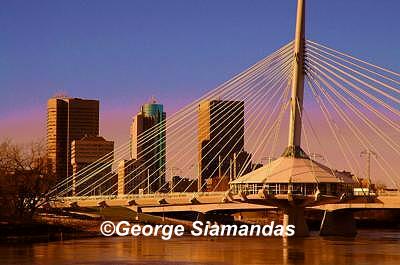
Winnipeg c1914
WINNIPEG'S SEARCH FOR A PURE
AND ABUNDANT WATER SUPPLY
By George Siamandas
INTRODUCTION
As Winnipeg started to sense the great potential of its future coupled with the serious typhus epidemic of it sought to find an abundant and pure source of water.
THE FIGHT FOR WATER
It was civic election night the evening of Dec 12, 1912. Throughout the city the lights blinked once signalling Thomas Russ Deacon had won the Mayoralty against JG Harvey. An opponenet of the aqueduct.
POOR WATER AND HIGH DEATH RATES
In the early 1900s clean, safe and abundant drinking was an ongoing problem. Drawn right out of the Assiniboine River water quality became worse and worse showing high faecal bacteria counts. In 1904, Winnipeg set a world record of 19.4 deaths per 1000.
SEARCHING FOR A SOLUTION
Through the 1900s, Winnipeg politicians avoided coming to terms with the water issue. Seeking cheap solutions in 1907 City's engineers recommended either artesian wells or water from Winnipeg River. But the city treasury was strapped.
WATER EXPERT
In studies done in 1912, US consultant Charles Slichter recommended Shoal Lake as having a perfect water supply. Slichter was a PhD, a professor from Madison, Wisconsin, and an international authority on water who had already advised Brooklyn NY, Los Angeles, St Louis, El Paso and Holland, on their water supplies.
He urged council that good water was worth the $13.5 M price tag. "Winnipeg has entered into a class of world cities. It cannot afford to be committed to a temporary solution and it should not postpone the inevitable." But it took a second man to get the project built.
THOMAS RUSS DEACON
Thomas Russ Deacon was born in Perth Ontario on January 3, 1865. In 1891 he earned a degree in civil engineering and became superintendent for the construction of the North Bay Ontario waterworks.
Deacon left Ontario in 1902 and came to Winnipeg. Deacon went into partnership with HB Lyall in the founding of the Manitoba Bridge and Iron Works.
AN ADVOCATE FOR GOOD WATER
Deacon became an advocate of Shoal Lake in 1902. It was during his stint in the Lake of the Woods area that he became familiar with the Shoal lake region.
In 1906 Deacon was appointed to the Water Supply Commission and soon let his preferences for the long-term benefits of the Shoal Lake source be known.
For the next decade the issue was debated for years with most Winnipeg politicians preferring the less costly options of using the Winnipeg River.
Only Deacon showed vision and was able to see through this political fog of uncertainty. He knew the water was of high quality, it was abundant, and its higher elevation meant it could flow simply and elegantly to Winnipeg by gravity alone.
Winnipeg the city with a future deserved Shoal Lake over other proposals like the Winnipeg River.
THE ELECTION OF 1912
The pivotal election was in 1912. Deacon was persuaded to run against Alderman JG Garvey at the last moment. The Telegram had supported Garvey on the basis of his 16 years of civic service. But Deacon knew that Garvey was against the Shoal Lake plan. Deacon felt it was Winnipeg's destiny to become a great city and the matter of high initial cost would be taken care of by future growth. If he believed in the aqueduct he had to become mayor.
Deacon ran a series of newspaper ads each bearing a new message. Deacon was not just for good and abundant water; he was also for a larger civic health department, better civic staff, and support to the Winnipeg General Hospital and workers compensation. His slogan became "Winnipeg demands progress."
Deacon felt it was Winnipeg's destiny to become a great city and the matter of high initial cost would be taken care of by future growth.
WINNIPEGGERS OPEN THEIR WALLETS FOR GOOD WATER
It was a year of recession and city budgets were strained. But Winnipeggers were convinced of the need to do the right thing. In October of 1913 they voted in favour of the Shoal Lake Aqueduct expenditure of $13.5 million. Deacon's leadership was well received, and at the same fall vote, Thomas Russ Deacon was re-elected mayor of Winnipeg.
Work on the Shoal Lake aqueduct began right away. It took five and a half years and ate up all of the $13.5 million, but on March 29, 1919, the work was completed.
The newly introduced water was allowed to settle for five days in the reservoir so that citizens could have appealing clear water on the official inaugural day of April 5. Deacon's contribution was recognized by naming the first major water reservoir after him.
AND JUST HOW GOOD WAS THE QUALITY OF WINNIPEG'S WATER?
People loved it. Winnipeg's water was considered the best in the country, and Winnipeg became the "Official Water Supplier" for the 1937 Royal Tour of Canada. It came out at the top of 100 waters in Canada.
Today the water is considered to be of high quality. Treatment was anticipated in the future, particularly as the public's expectations increase. Is that time now?


1 comment:
When was flouridation introduced into the City's water supply and what scientific evidence is there that fluoridation has contributed to diseases that are now common in childred such as asthma which was uncommone prior to the introduction of fluoridation.
Post a Comment